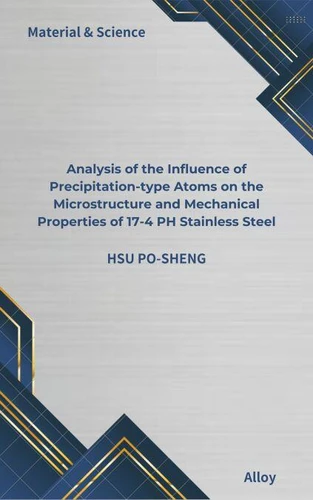Analysis of the Influence of Precipitation-type Atoms on the Microstructure and Mechanical Properties of 17-4 PH Stainless Steel
Par :Formats :
Disponible dans votre compte client Decitre ou Furet du Nord dès validation de votre commande. Le format ePub est :
- Compatible avec une lecture sur My Vivlio (smartphone, tablette, ordinateur)
- Compatible avec une lecture sur liseuses Vivlio
- Pour les liseuses autres que Vivlio, vous devez utiliser le logiciel Adobe Digital Edition. Non compatible avec la lecture sur les liseuses Kindle, Remarkable et Sony
 , qui est-ce ?
, qui est-ce ?Notre partenaire de plateforme de lecture numérique où vous retrouverez l'ensemble de vos ebooks gratuitement
Pour en savoir plus sur nos ebooks, consultez notre aide en ligne ici
- FormatePub
- ISBN8224005376
- EAN9798224005376
- Date de parution13/03/2024
- Protection num.pas de protection
- Infos supplémentairesepub
- ÉditeurVirtued Press
Résumé
In recent years, with the continuous development of the steel industry, demand has been increasing, and its applications have become increasingly diversified. Processing methods and the microstructure of the surface are indispensable aspects. This experiment utilized five different precipitation-strengthened stainless steels (17-4PH) as materials, exploring the effects of varying elemental compositions.
The study focused on investigating the tensile stress, cross-sectional area shrinkage, yield strength, elongation, and observing changes in microstructures under the same processing conditions but with different proportions of elements. The elemental constituents of the materials included carbon (C), silicon (Si), manganese (Mn), phosphorus (P), sulfur (S), nickel (Ni), chromium (Cr), molybdenum (Mo), nitrogen (N), niobium (Nb), copper (Cu), etc., with a primary focus on nickel (Ni), carbon (C), nitrogen (N), and copper (Cu).
For microstructure observations, scanning electron microscopy (SEM) and transmission electron microscopy (TEM) were employed, while X-ray diffraction (XRD) was used for further compositional analysis or substrate examination.
The study focused on investigating the tensile stress, cross-sectional area shrinkage, yield strength, elongation, and observing changes in microstructures under the same processing conditions but with different proportions of elements. The elemental constituents of the materials included carbon (C), silicon (Si), manganese (Mn), phosphorus (P), sulfur (S), nickel (Ni), chromium (Cr), molybdenum (Mo), nitrogen (N), niobium (Nb), copper (Cu), etc., with a primary focus on nickel (Ni), carbon (C), nitrogen (N), and copper (Cu).
For microstructure observations, scanning electron microscopy (SEM) and transmission electron microscopy (TEM) were employed, while X-ray diffraction (XRD) was used for further compositional analysis or substrate examination.
In recent years, with the continuous development of the steel industry, demand has been increasing, and its applications have become increasingly diversified. Processing methods and the microstructure of the surface are indispensable aspects. This experiment utilized five different precipitation-strengthened stainless steels (17-4PH) as materials, exploring the effects of varying elemental compositions.
The study focused on investigating the tensile stress, cross-sectional area shrinkage, yield strength, elongation, and observing changes in microstructures under the same processing conditions but with different proportions of elements. The elemental constituents of the materials included carbon (C), silicon (Si), manganese (Mn), phosphorus (P), sulfur (S), nickel (Ni), chromium (Cr), molybdenum (Mo), nitrogen (N), niobium (Nb), copper (Cu), etc., with a primary focus on nickel (Ni), carbon (C), nitrogen (N), and copper (Cu).
For microstructure observations, scanning electron microscopy (SEM) and transmission electron microscopy (TEM) were employed, while X-ray diffraction (XRD) was used for further compositional analysis or substrate examination.
The study focused on investigating the tensile stress, cross-sectional area shrinkage, yield strength, elongation, and observing changes in microstructures under the same processing conditions but with different proportions of elements. The elemental constituents of the materials included carbon (C), silicon (Si), manganese (Mn), phosphorus (P), sulfur (S), nickel (Ni), chromium (Cr), molybdenum (Mo), nitrogen (N), niobium (Nb), copper (Cu), etc., with a primary focus on nickel (Ni), carbon (C), nitrogen (N), and copper (Cu).
For microstructure observations, scanning electron microscopy (SEM) and transmission electron microscopy (TEM) were employed, while X-ray diffraction (XRD) was used for further compositional analysis or substrate examination.



